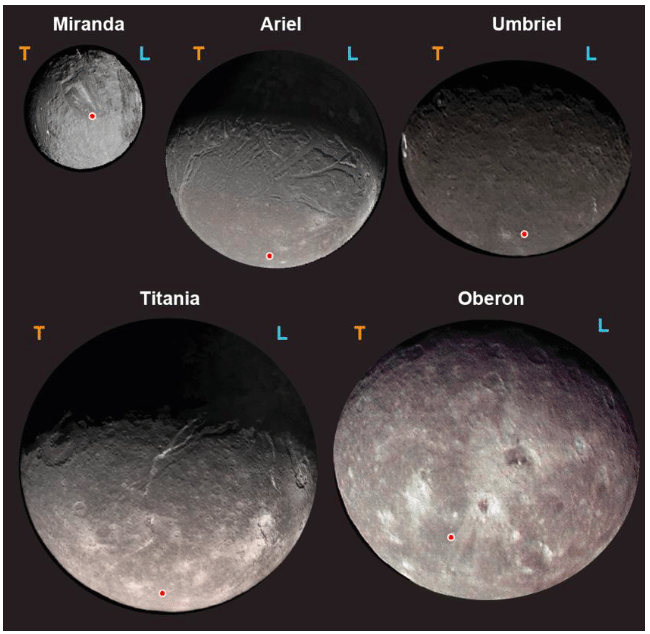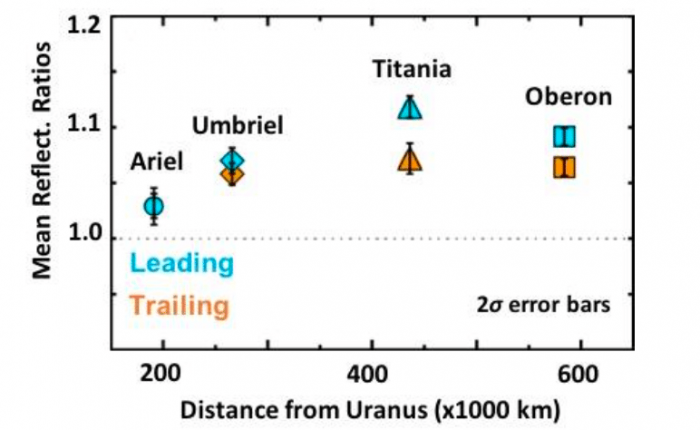
The seventh most distant planet in our Solar System, Uranus, is orbited by the mid-sized regular satellites Miranda, Ariel, Umbriel, Titania, and Oberon (Figure 1). The innermost moon Miranda is the smallest (diameter 472 km), the middle moons Ariel and Umbriel are also the middle two in terms of size (diameters of 1158 km and 1170 km, respectively), and the outer moons Titania and Oberon are the largest (diameters of 1578 km and 1524 km, respectively).

Figure 1: Voyager 2/ISS image mosaics of the five large moons of Uranus (courtesy NASA/JPL-Caltech/USGS), with night-side sections of Ariel and Titania revealed using ‘Uranus shine’ (Stryk and Stooke, 2008), qualitatively scaled to their relative sizes. Imaged sections of each moon’s leading (blue L) and trailing (orange T) hemispheres, and the approximate location of their south poles (red circle) shown as well. Published with permission from Elsevier https://linkinghub.elsevier.com/retrieve/pii/S0019103517307868).
Like the Earth’s Moon, the five large Uranian satellites are in tidally-locked orbits, which means the amount of time it takes for each moon to orbit Uranus is the same as the time it takes for each moon to complete one rotation (ranging from about 1.4 days for the innermost Miranda to about 13.5 days for the outermost Oberon). Consequently, the same leading hemisphere faces in the forward direction, and the same trailing hemisphere faces a backward direction as the tidally-locked Uranian moons complete their orbits. Over geologic timescales, the leading and trailing hemispheres of tidally-locked objects can be modified by different processes and/or at different rates.
The surface compositions of the large moons of Uranus are dominated by H2O ice and a mixture of dark material with reflectance properties similar to charcoal (e.g., Cruikshank et al., 1977). Overprinting this base composition of “dirty ice,” spectrally-red material (i.e., material that increases in brightness with increasing wavelength) has also been detected, primarily on the leading hemispheres of the outer moons Titania and Oberon (Buratti and Mosher, 1991). Numerical modeling indicates that the most likely source of this red material is dust from the spectrally-red surfaces of the irregular satellites that have retrograde orbits (i.e., orbiting in the opposite direction of Uranus’ rotation and the five large prograde regular moons) (Tamayo et al., 2013).
These modeling efforts indicate that dust grains liberated from the red surfaces of retrograde irregular satellites go into orbit around Uranus. Over millions of years, the orbits of these dust grains decay due to Poynting-Robertson drag (Burns et al., 1979), and they slowly fall toward Uranus. Eventually, the orbits of the dust grains decay into the orbital zone of the five large regular moons, where they primarily collide with the leading hemispheres of the outer moons Titania and Oberon. A small amount of the in-falling dust bypasses Titania and Oberon to collide with the leading hemispheres of the inner moons Ariel and Umbriel, but essentially no dust survives to collide with the innermost moon Miranda.
The detection of red material on the large Uranian moons was made using data collected during the Voyager 2 flyby of the Uranian system when the subsolar point was near 81°S (i.e., close to southern summer solstice). Consequently, the datasets collected by Voyager 2 primarily sampled the southern latitudes of these moons because their northern latitudes were shrouded by winter darkness. Red dust from the irregular satellites should accumulate fairly evenly at both southern and northern latitudes of the large Uranian moons.
Therefore, to test this irregular satellite dust accumulation hypothesis further, we collected new data over the now observable northern latitudes of these moons (subsolar point ~20 to 40°N), using the SpeX spectrograph at NASA’s Infrared Telescope Facility (Rayner et al., 2003). Our results indicate that the northern latitudes of these moons display similar trends in reddening to their southern latitudes, with more spectral reddening on the leading sides of the outer moons (Figure 2), thereby supporting an irregular satellite origin for the red constituent detected on the large moons of Uranus.

Figure 2: The degree of reddening on the large moons of Uranus shown as mean reflectance ratios (R1.26 μm/R0.72 μm) for the leading (blue) and trailing (orange) hemispheres of Ariel, Umbriel, Titania, and Oberon. The leading and trailing hemispheres of the inner moons, Ariel and Umbriel, display similar degrees of reddening, whereas the leading hemispheres of the outer moons, Titania and Oberon, are clearly redder than their trailing hemispheres. Published with permission from Elsevier https://linkinghub.elsevier.com/retrieve/pii/S0019103517307868).
Thus, the Uranian satellite system is more complex than we had originally suspected, with the surfaces of the large moons of Uranus possibly being modified by the accumulation of red dust from retrograde irregular satellites. Whether dust accumulation is occurring presently, or whether the red material was accumulated in the distant past is still unknown. In the Saturnian system, instruments onboard the Cassini spacecraft detected a diffuse cloud of dust around the irregular satellite Phoebe (Verbiscer et al., 2009; Tamayo et al., 2014).
It is very likely that this cloud of dust eventually migrates inward and accumulates on the leading hemisphere of the large Saturnian moon Iapetus. Detection of a similar cloud of dust around the Uranian irregular satellites would provide strong evidence of dust accumulation on the large regular moons. However, it is challenging to detect these sorts of diffuse dust clouds without the benefit of an orbiting spacecraft like Cassini in the Uranian system. Future generation ground- and space-based telescopes, like NASA’s James Webb Space Telescope (set to launch in 2021), could have the sensitivity needed to detect faint clouds of dust around irregular satellites in the Uranian system.
These findings are described in the article entitled Red material on the large moons of Uranus: Dust from the irregular satellites? recently published in the journal Icarus. This work was conducted by Richard J. Cartwright from the SETI Institute, Joshua P. Emery and Michael P. Lucas from the University of Tennessee, Noemi Pinilla-Alonso from the University of Central Florida, Andy S. Rivkin from the John Hopkins University Applied Physics Laboratory, and David E. Trilling from Northern Arizona University.
References:
- Buratti, B.J., Mosher, J.A., 1991. Comparative global albedo and color maps of the Uranian satellites. Icarus 90 (1), 1.
- Burns, J.A., Lamy, P.L., Soter, S., 1979. Radiation forces on small particles in the solar system. Icarus 40 (1), 1.
- Cruikshank, D.P., Morrison, D., Pilcher, C.B., 1977. Identification of a new class of satellites in the outer solar system. Astrophys. J. 217, 1006.
- Rayner, J.T., et al., 2003. SpeX: a medium-resolution 0.8–5.5 micron spectrograph and imager for the NASA Infrared Telescope Facility. Astron. Soc. Pacific 115, 362.
- Tamayo, D., Burns, J.A., Hamilton, D.P., 2013a. Chaotic dust dynamics and implications for the hemispherical color asymmetries of the Uranian satellites. Icarus 226 (1), 655.
- Tamayo, D., Hedman, M.M., Burns, J.A., 2014. First observations of the Phoebe ring in optical light. Icarus 233, 1.
- Verbiscer, A.J., Skrutskie, M.F., Hamilton, D.P., 2009. Saturn’s largest ring. Nature 461 (7267), 1098.









